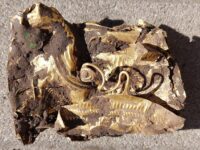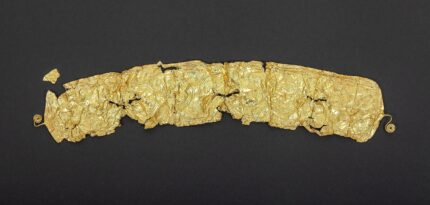 A farmer harvesting sugar beets from his field near Opava in the eastern Czech Republic, dug up a unique gold belt dating to the Bronze Age. The finder, who wishes to remain anonymous, found the shiny yellow object crumpled into a ball. He rinsed it, straightened it out a little and realized this was an artifact of archaeological significance. He immediately contacted the Silesian Regional Museum and emailed photographs of the find to the head of its archaeology department, Jiří Juchelek who recognized that it was a unique ancient object.
A farmer harvesting sugar beets from his field near Opava in the eastern Czech Republic, dug up a unique gold belt dating to the Bronze Age. The finder, who wishes to remain anonymous, found the shiny yellow object crumpled into a ball. He rinsed it, straightened it out a little and realized this was an artifact of archaeological significance. He immediately contacted the Silesian Regional Museum and emailed photographs of the find to the head of its archaeology department, Jiří Juchelek who recognized that it was a unique ancient object.
The finder brought the artifact into the museum where Juchelek and his colleagues examined it with a spectrum analyzer to determine its composition. It is a gold alloy of more than 84% gold, 15% silver, copper and assorted trace elements. These percentages correspond to those found in other prehistoric metal artifacts in the area. Experts from other institutions were consulted regarding the decorative style of the diadem to help narrow down the date. The decoration indicates that it was made at the turn of the Middle and Late Bronze Age, ca. 1400-800 B.C.
The piece is 20 inches long and four inches wide and weighs 60 grams (2.1 oz). It is made of a single thin gold sheet decorated with a sequence of five large concentric circles adjacent to each other in the center. Smaller concentric circles fill the gaps above and below the large ones and line up in rows and columns at both ends of the belt. Triple borders incised with short, angled lines adorn the top, bottom and edges. Two swirls of gold on each end were likely wound together as a clasp.
The first hypothesis was that the thin golden sheet of metal, which is around 50 centimetres long, was a tiara. However, after examining the object in greater detail, experts now believe it was actually part of a belt:
[Jiří Juchelka says,] “We realized that it was too long to fit on someone’s head. So we actually think it is not a tiara, but something much rarer – a part of a belt.
“Belts at the time were made of leather and this was strapped to its front part. It was crumpled when the finder found it, probably as a result of agricultural activity, so it is a miracle it has been so well preserved. It may be missing a few tiny parts, but otherwise it is in perfect condition.”
Even producing a plain gold sheet of these dimensions in the Bronze Age would have required enormous technical skill. The elaborate decoration adds even more difficulty and can only have been accomplished by a superior craftsman. An object of such rarity and expense probably belonged to a member of the societal elite.
The finder surrendered the belt to the regional cultural patrimony organization. Once the piece has been evaluated and assessed for market value, our beet farming friend will receive a reward in the amount of 20% of the estimate. When study and conservation is complete, the artifact will go on public display at the Bruntál Museum.

